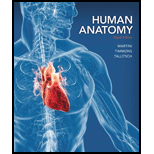
Human Anatomy (8th Edition) - Standalone book
8th Edition
ISBN: 9780321883322
Author: Frederic H. Martini, Robert B. Tallitsch
Publisher: PEARSON
expand_more
expand_more
format_list_bulleted
Question
Chapter 4, Problem 17RFT
Summary Introduction
Introduction:
The integumentary system is composed of the cutaneous membrane (skin) and accessory structures (hair, nails, and exocrine glands). It covers the body and acts as a covering. It has many functions including synthesis and storage of lipids, synthesis of vitamin D3, prevention of microbial infection, and many more.
Expert Solution & Answer
Want to see the full answer?
Check out a sample textbook solution
Students have asked these similar questions
please draw in what the steps are given.
Thank you!
please draw in and fill out the empty slots from image below.
thank you!
There is a species of eagle, which lives in a tropical forest in Brazil. The alula pattern of its wings is determined by a single autosomal gene with four alleles that exhibit an unknown hierarchy of dominance. Genetic testing shows that individuals 1-1, 11-4, 11-7, III-1, and III-4 are each homozygous.
How many possible genotypes among checkered eagles in the population?
Chapter 4 Solutions
Human Anatomy (8th Edition) - Standalone book
Ch. 4 - Match each numbered item with the most closely...Ch. 4 - Match each numbered item with the most closely...Ch. 4 - Match each numbered item with the most closely...Ch. 4 - Match each numbered item with the most closely...Ch. 4 - Match each numbered item with the most closely...Ch. 4 - Match each numbered item with the most closely...Ch. 4 - Match each numbered item with the most closely...Ch. 4 - Match each numbered item with the most closely...Ch. 4 - Prob. 9RFTCh. 4 - Label the following structures on the accompanying...
Ch. 4 - The effects of aging on the skin include (a) a...Ch. 4 - Prob. 12RFTCh. 4 - Label the following structures on the accompanying...Ch. 4 - Prob. 14RFTCh. 4 - 15. The layer of the epidermis that contains cells...Ch. 4 - Prob. 16RFTCh. 4 - Prob. 17RFTCh. 4 - Prob. 18RFTCh. 4 - Prob. 19RFTCh. 4 - Explain why fair-skinned individuals have greater...Ch. 4 - Prob. 2RCCh. 4 - Stretch marks are often seen on individuals who...Ch. 4 - Prob. 4RCCh. 4 - 5. List the characteristics that make the...Ch. 4 - Prob. 6RCCh. 4 - 7. Explain what is happening to a person who is...Ch. 4 - Prob. 8RCCh. 4 - 1. You are about to undergo surgery. Explain why...Ch. 4 - Prob. 2CT
Knowledge Booster
Learn more about
Need a deep-dive on the concept behind this application? Look no further. Learn more about this topic, biology and related others by exploring similar questions and additional content below.Similar questions
- students in a science class investiged the conditions under which corn seeds would germinate most successfully. BAsed on the results which of these factors appears most important for successful corn seed germination.arrow_forwardI want to write the given physician orders in the kardex formarrow_forwardAmino Acid Coclow TABle 3' Gly Phe Leu (G) (F) (L) 3- Val (V) Arg (R) Ser (S) Ala (A) Lys (K) CAG G Glu Asp (E) (D) Ser (S) CCCAGUCAGUCAGUCAG 0204 C U A G C Asn (N) G 4 A AGU C GU (5) AC C UGA A G5 C CUGACUGACUGACUGAC Thr (T) Met (M) lle £€ (1) U 4 G Tyr Σε (Y) U Cys (C) C A G Trp (W) 3' U C A Leu בוט His Pro (P) ££ (H) Gin (Q) Arg 흐름 (R) (L) Start Stop 8. Transcription and Translation Practice: (Video 10-1 and 10-2) A. Below is the sense strand of a DNA gene. Using the sense strand, create the antisense DNA strand and label the 5' and 3' ends. B. Use the antisense strand that you create in part A as a template to create the mRNA transcript of the gene and label the 5' and 3' ends. C. Translate the mRNA you produced in part B into the polypeptide sequence making sure to follow all the rules of translation. 5'-AGCATGACTAATAGTTGTTGAGCTGTC-3' (sense strand) 4arrow_forward
- What is the structure and function of Eukaryotic cells, including their organelles? How are Eukaryotic cells different than Prokaryotic cells, in terms of evolution which form of the cell might have came first? How do Eukaryotic cells become malignant (cancerous)?arrow_forwardWhat are the roles of DNA and proteins inside of the cell? What are the building blocks or molecular components of the DNA and proteins? How are proteins produced within the cell? What connection is there between DNA, proteins, and the cell cycle? What is the relationship between DNA, proteins, and Cancer?arrow_forwardWhy cells go through various types of cell division and how eukaryotic cells control cell growth through the cell cycle control system?arrow_forward
arrow_back_ios
SEE MORE QUESTIONS
arrow_forward_ios
Recommended textbooks for you
 Human Biology (MindTap Course List)BiologyISBN:9781305112100Author:Cecie Starr, Beverly McMillanPublisher:Cengage Learning
Human Biology (MindTap Course List)BiologyISBN:9781305112100Author:Cecie Starr, Beverly McMillanPublisher:Cengage Learning Comprehensive Medical Assisting: Administrative a...NursingISBN:9781305964792Author:Wilburta Q. Lindh, Carol D. Tamparo, Barbara M. Dahl, Julie Morris, Cindy CorreaPublisher:Cengage Learning
Comprehensive Medical Assisting: Administrative a...NursingISBN:9781305964792Author:Wilburta Q. Lindh, Carol D. Tamparo, Barbara M. Dahl, Julie Morris, Cindy CorreaPublisher:Cengage Learning

Human Biology (MindTap Course List)
Biology
ISBN:9781305112100
Author:Cecie Starr, Beverly McMillan
Publisher:Cengage Learning




Comprehensive Medical Assisting: Administrative a...
Nursing
ISBN:9781305964792
Author:Wilburta Q. Lindh, Carol D. Tamparo, Barbara M. Dahl, Julie Morris, Cindy Correa
Publisher:Cengage Learning

The Integumentary System, Part 1 - Skin Deep: Crash Course Anatomy & Physiology #6; Author: CrashCourse;https://www.youtube.com/watch?v=Orumw-PyNjw;License: Standard youtube license